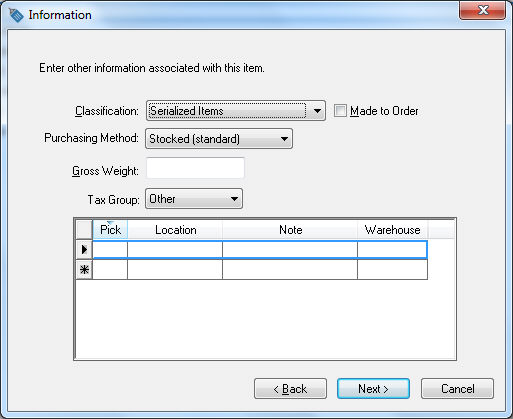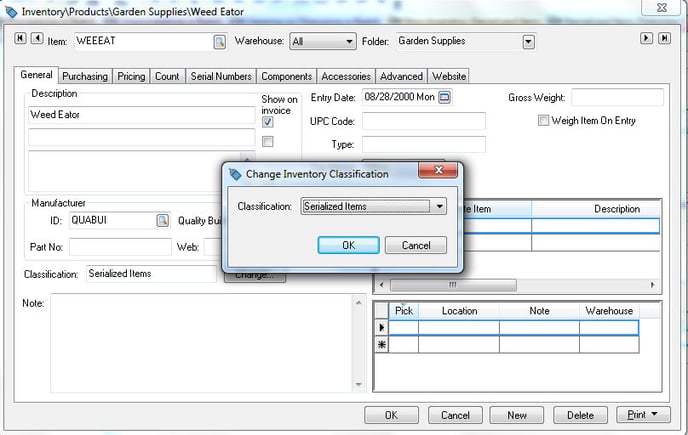- EBMS Knowledge Base
- Inventory
- Serialized Items
-
Client Resources
-
EBMS Main Documentation
- Introduction
- Getting Started
- Getting Started | Initial Installation
- Getting Started | Company Setup
- Quick User Guide | Financial Staff | Accountant
- Quick User Guide | Financial Staff | Accountant | Accountants Journal
- Quick User Guide | Sales Staff
- Quick User Guide | General Staff
- Features
- Reports
- Security
- Server Manager
- Technical
- Technical | Data Import and Export Utility
- Technical | SQL Mirror
- Automotive
- Automotive | Parts Catalog
- Automotive | Pricing
- Automotive | Point of Sale
- Automotive | Product Application
- Automotive | Keystone Interface
- Metal Supply
- Fuel Sales
- Horticulture
- Horticulture | Farm Setup
- Horticulture | Processing Payroll
- Horticulture | Managing the Farm
-
Sales
- Introduction
- Customers
- Customers | Miscellaneous Customers
- Proposals
- Proposals | Processing Proposals
- Proposals | Sets and Templates
- MyProposals
- MyOrders
- Sales Orders
- Invoices
- Materials Lists
- Sales and Use Tax
- Sales and Use Tax | TaxJar
- CRM
- CRM | Auto Send
- Recurring Billing
- Credits
- Customer Payments
- Payment Card Processing
- Payment Card Processing | Gift Cards
- Payment Card Processing | Loyalty Cards
- Payment Card Processing | Verifone Gateway
- Freight and Shipping Tools
- General Ledger Transactions
- Point of Sale
- Point of Sale | Point of Sale Hardware
- Point of Sale | Xpress POS System
- Point of Sale | Advanced Tools
- Signature Capture
- Salesperson Commissions
-
Inventory
- Product Catalog
- Product Catalog | Using Product Codes for No Count Items
- Product Pricing
- Product Pricing | Special Pricing
- Tracking Counts
- Unit of Measure
- Purchasing
- Special Orders and Drop Shipped Items
- Receiving Product
- Barcodes
- MyInventory and Scanner
- Components (BOM) and Accessories
- Components (BOM) and Accessories | Component Formula Tool
- Made-to-Order Kitting
- Configure-to-Order Kitting
- Multiple Inventory Locations
- Multiple Inventory Locations | Creating Locations
- Multiple Inventory Locations | Using Multiple Locations
- Multiple Inventory Locations | Product Catalog Sync
- Multi-Vendor Catalog
- Serialized Items
- Serialized Items | Purchasing or Manufacturing an Item
- Serialized Items | Selling and/or Associating an item with a customer
- Lots
- Product Attributes
- Product Attributes | Selling and Purchasing Items with Attributes
- Product Attributes | Custom Attributes
- Mobile Scanner (Legacy)
-
Labor
- Getting Started
- Workers
- Taxes and Deductions
- Work Codes
- Time and Attendance
- Time and Attendance | Time Track App
- Processing Payroll
- Closing the Payroll Year
- Processing Payroll - Advanced
- Salaried Pay
- Piecework Pay
- Direct Deposit
- 3rd Party Payroll Service
- Subcontract Workers
- Flag Pay
- Prevailing Wages
- MyDispatch
- MyTasks
- MyTime
- MyTime | Communications
- MyTime | Setup
- Tasks
- Tasks | Getting Started
- Tasks | Creating Tasks
- Tasks | Scheduling Tasks
- Tasks | Customizing Task Views
- Tasks | Managing Tasks
-
Financials
- Introduction
- Fiscal Year
- Chart of Accounts
- Budget
- Financial Reporting
- Transactions and Journals
- Transactions and Journals | Journals
- Account Reconciliation
- 1099
- Departments and Profit Centers
- Fund Accounts
- Bank Accounts
- Bank Feed
- Vendors
- Vendors | Miscellaneous Vendors
- Purchase Orders
- Expense Invoices
- Vendor Payments
- AP Transactions
- Landed Cost
- Fixed Assets and Depreciation
- Fixed Assets and Depreciation | Fixed Assets
- Fixed Assets and Depreciation | Fixed Assets | Adding Assets
- Fixed Assets and Depreciation | Processing Depreciation
- Fixed Assets and Depreciation | Disposing Assets
- MyJobs
-
E-commerce
-
Rental
-
Job Costing
-
Manufacturing
Classifying a Serialized item
An inventory item must be created and classified as a Serialized Item before serial numbers can be entered or processed. The inventory item identifies the line of products that is being serialized. The purchase and sales history will be summarized at the inventory item level. For example, an inventory item must be created for the air conditioner or lawn mower based on the make and model of the unit. The serial number identifies each individual item. If an inventory item is classified as a serialized item, a serial number must be entered for each item purchased or manufactured. The three following serialized item classifications can be used based on the needs of the user:
-
Use the Serialized Item classification for items that are purchased and resold. This is the most common classification used within EBMS. Continue within this section for details on using this classification.
-
Use the Non-Inventory Serialized Item classification for non-inventory items such as rentals. Review the following Non-Inventory Serialized Item section for more details on non-inventory serialized items.
-
Use the MTO Serialized Item classification for Made-To-Order items such as custom manufactured equipment. Review the Made-To-Order Serialized Items for more details.
Review the Product Catalog > Changing and Item Classification for instructions to change an existing item to a serialized item Classification.
Create New Serialized Item
Take the following steps to create and classify a new inventory item:
-
Launch the new inventory item wizard. Review the Product Catalog > Entering New Products section for more details on the new inventory item wizard.
-
Enter the product description in the first page of the new item wizard and click the next button.
-
Select the Serialized item option from the Classification options as shown below:

Inventory that is classified as Serialized Items will generate the same general transactions as an item classified as Track Count. Review the Non-Inventory Serialized Item section for information on serialized items that do not generate perpetual inventory general ledger transactions. -
Complete the new item wizard as described in the Product Catalog > Entering New Products section.
Classify an Existing Item as Serialized
Complete the following steps to classify an existing inventory item as a serialized item: The Count value within the Count tab must be zero to change the classification of an inventory item. Review the Tracking Counts > Adjusting Inventory Count and Values section for more details on adjusting counts.
-
Open the inventory item and click on the General tab as shown below:
-
Click on the Change button to the right of the Classification field to open the Change Inventory Classification dialog.

-
Select the Serialized Items classification and click the OK button.
